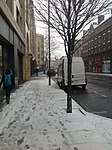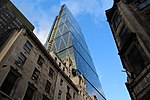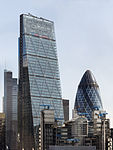The Scalpel

The Scalpel is a commercial skyscraper in London, United Kingdom. It is located on Lime Street in the City of London financial area. Originally a nickname but subsequently designated as its official name, the term "Scalpel" was coined by the Financial Times due to the building's distinctive angular design. The building has also been noted for its similarity to a "play" media button due to how it looks from South of the River Thames. This follows a trend of nicknaming new buildings based upon their shape, such as the nearby Leadenhall Building, also known as "The Cheesegrater". Completed in 2018, The Scalpel at 52 Lime Street is 190 m (620 ft) tall, with 38 storeys. It was designed by Kohn Pedersen Fox. The Scalpel at 52 Lime Street is on the corner of Lime Street and Leadenhall Street, opposite the Lloyd's building and adjacent to the Willis Building. The skyscraper has been built for insurance company W. R. Berkley and is the firm's new European headquarters, occupying approximately one-quarter of the total office space. Other tenants that have leased space include Axis Novae, National Australia Bank, Morrison & Foerster, Britannia Financial Group, and Convex.
Excerpt from the Wikipedia article The Scalpel (License: CC BY-SA 3.0, Authors, Images).The Scalpel
Leadenhall Street, City of London
Geographical coordinates (GPS) Address Website External links Nearby Places Show on map
Geographical coordinates (GPS)
| Latitude | Longitude |
|---|---|
| N 51.513258 ° | E -0.081453 ° |
Address
Leadenhall Street 52
EC3A 4AA City of London
England, United Kingdom
Open on Google Maps










